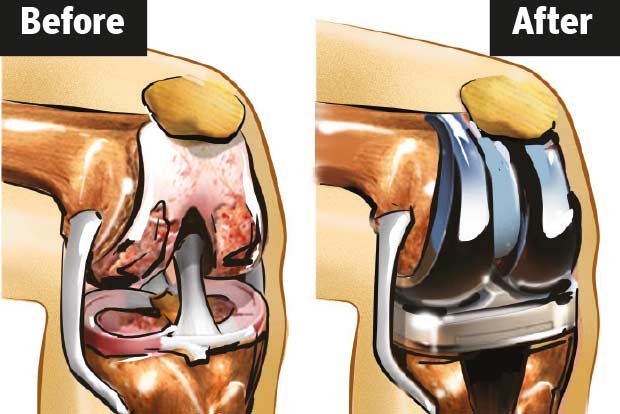Dr Amit Saoji | Orthopedic Surgeon In Nagpur | Orthopedic Doctor in Nagpur
Knee Replacement Surgery In Nagpur
Home / Knee Replacement Surgery In Nagpur

Knee Replacement Surgery
Knee replacement, additionally known as knee surgical operation or total knee replacement, may be a surgical operation to resurface a knee broken by inflammatory disease. Metal and plastic components ar accustomed cap the ends of the bones that kind the knee, together with the kneecap. This surgery is also thought of for somebody World Health Organization has severe inflammatory disease or a severe knee injury.
Various varieties of inflammatory disease could have an effect on the knee. degenerative joint disease, a chronic joint unwellness that affects largely old and older adults, could cause the breakdown of joint animal tissue and adjacent bone within the knees. autoimmune disease, that causes inflammation of the tissue layer and leads to excessive synovia, will cause pain and stiffness. Traumatic inflammatory disease, inflammatory disease thanks to injury, could cause injury to the animal tissue of the knee. The goal of knee replacement surgery is to resurface the components of the knee that are broken and to alleviate knee pain that can’t be controlled by alternative treatments.
Why Do Yout Need Knee Replacement Surgery?
Your doctor may recommend that you undergo a knee arthroscopy if you’re experiencing knee pain. Your doctor might have already diagnosed the condition causing your pain, or they may order the arthroscopy to help find a diagnosis. In either case, an arthroscopy is a useful way for doctors to confirm the source of knee pain and treat the problem.
Arthroscopic surgery can diagnose and treat knee injuries, including:
torn anterior or posterior cruciate ligaments
torn meniscus (the cartilage between the bones in the knee)
patella that’s out of position
pieces of torn cartilage that are loose in the joint
removal of a Baker’s cyst
fractures in the knee bones
swollen synovium (the lining in the joint)
What Happens During a Knee Arthroscopy?
Your doctor will give you an anesthetic before your knee arthroscopy. This may be:
local (numbs your knee only)
regional (numbs you from the waist down)
general (puts you completely to sleep)
If you’re awake, you may be able to watch the procedure on a monitor.
The surgeon will begin by making a few small incisions, or cuts, in your knee. Sterile salt water, or saline, will then pump in to expand your knee. This makes it easier for the surgeon to see inside the joint. The arthroscope enters one of the cuts and the surgeon will look around in your joint using the attached camera. The surgeon can see the images produced by the camera on the monitor in the operating room.
When the surgeon locates the problem in your knee, they may then insert small tools into the incisions to correct the issue. After the surgery, the surgeon drains the saline from your joint and closes your cuts with stitches.
Anatomy of the Knee
The knee is that the largest joint within the body and having healthy knees is needed to perform most everyday activities.The knee is created of the lower finish of the femoris (femur), the higher finish of the leg bone (tibia), and therefore the kneecap (patella). The ends of those 3 bones area unit lined with body part gristle, a sleek substance that protects the bones and permits them to maneuver simply inside the joint.
The menisci area unit situated between the thighbone and leg bone. These C-shaped wedges act as “shock absorbers” that cushion the joint.
Large ligaments hold the thighbone and leg bone along and supply stability. The long thigh muscles provide the knee strength.
All remaining surfaces of the knee area unit lined by a skinny lining referred to as the synovium. This membrane releases a fluid that lubricates the gristle, reducing friction to just about zero in a very healthy knee.
Normally, all of those elements add harmony. however sickness or injury will disrupt this harmony, leading to pain, muscle weakness, and reduced operate.
Description
A knee replacement (also referred to as knee arthroplasty) can be additional accurately termed a knee “resurfacing” as a result of solely the surface of the bones area unit replaced.
There are four basic steps to a knee replacement procedure:
- Prepare the bone : The broken gristle surfaces at the ends of the thighbone and leg bone area unit removed together with a tiny low quantity of underlying bone.
- Position the metal implants : The removed gristle and bone is replaced with metal elements that recreate the surface of the joint. These metal components could also be cemented or “press-fit” into the bone.
- Resurface the patella : The side of the patella (kneecap) is cut and resurfaced with a plastic button. Some surgeons don’t resurface the patella, relying upon the case.
- Insert a spacer : A medical-grade plastic spacer is inserted between the metal elements to make a sleek soaring surface.
